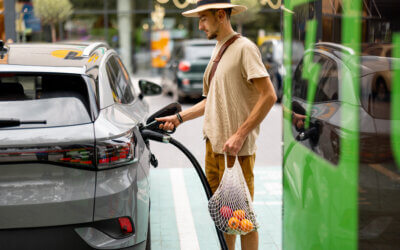While climate change can seem to be on an unstoppable march forward, the last decade has seen some wins for environmental causes too. One major victory for the environment has been a decrease in the use of plastic bags like those used at grocery stores. Cities around the world have banned them, and many consumers have opted for reusable bags—all in a joint effort to reduce waste. However, sometimes these seemingly good choices have unintended consequences. Even though many have stopped using small plastic store bags, their larger counterpart has been on the rise. Trash bags, such as the little 4-gallon variety commonly used in kitchens and bathrooms, have risen in sales by nearly 120% recently in cities where plastic grocery bags were banned. [1] Often, trash bags and their impact on the environment go unnoticed, but the truth is, their carbon footprint is significant, and the need to reduce them is urgent. Keep reading to learn more about this problem and how you can help fix it.
What Is the Carbon Footprint of Trash Bags?
The exact carbon footprint of each trash bag can vary depending on many factors, including what it’s made of, how it was manufactured, how long it traveled to get to its destination, and ultimately how it is disposed of. [2] Plastic trash bags are part of a larger plastics industry, which has a huge carbon footprint that is only expected to grow. By some estimates, plastic production and incineration could be responsible for over 56 gigatons of carbon between now and 2050. [3] And annual could grow to be more than 2.75 billion tonnes every year. [4]
What Environmental Problems Can Arise From Single-Use Plastic Trash Bags?
Beyond the carbon footprint, single-use plastic bags have many other negative impacts on the environment. Some of the reasons plastic trash bags are harmful include:
-
- Plastic trash bags could take hundreds of years to break down. [5]
- Most trash bags are made from low-density polyethylene (LDPE), which is manufactured using non-renewable fossil fuels. [6]
- Plastic trash bags can break down into microplastics, which are increasingly contaminating the oceans, harming marine animals, and entering our food supply. [7]
How to Reduce the Carbon Footprint of Trash Bag Usage
Even with the negative impact of traditional single-use plastic garbage bags, there are some green alternatives anyone can adopt. Below are some smart and simple ways you can start to reduce the carbon footprint of your trash bags.
Alternative Sources
There are many compelling reasons people choose to use plastic trash bags. They are convenient and help manage smelly, wet garbage that may otherwise become unmanageable. However, with proper planning, you can begin to separate your trash to help avoid plastic bags altogether. Start by finding alternative sources for your trash by doing the following:
- Compost food scraps to eliminate slimy, wet waste
- Recycle all your paper, glass, and metal
- Consider skipping trash bags and using a washable bin for what is leftover
Eco-Friendly Trash Bags
When a bag is unavoidable, then opt for eco-friendly alternatives. While a plastic bag is great for putting your trash out on the curb, they are not biodegradable and contribute to fossil fuel production and greenhouse gas emissions. So, next time you have to buy bags, look for the following alternatives:
- 100% recycled plastic bags
- Compostable trash bags
- Biodegradable trash bags
- Paper bags
- Switch to a can you can wash and reuse
How to Offset Your Carbon Footprint of Trash Bags?
For now, trash bags remain an inevitable part of our daily lives. From where we live and work to the places we shop and eat, chances are you throw something away into a plastic garbage bag every day. To truly eliminate that footprint, a more holistic approach is needed. One way to begin is by looking at your monthly carbon footprint and strategize comprehensive ways to reduce it. Those wishing to go neutral can take advantage of carbon offsets like those offered by Terrapass. You can learn more by calculating your footprint today using our free online carbon footprint calculator.
Brought to you by terrapass.com
Sources
Goldsberry, Clare. “The Unintended Consequences of Plastic Bag Bans.” PlasticsToday, 24 Apr. 2019, www.plasticstoday.com/packaging/unintended-consequences-plastic-bag-bans/34943847760696.
Clark, Duncan. “What’s a Carbon Footprint and How Is It Worked out?” The Guardian, Guardian News and Media, 4 Apr. 2012, www.theguardian.com/environment/2012/apr/04/carbon-footprint-calculated.
Joyce, Christopher. “Plastic Has A Big Carbon Footprint – But That Isn’t The Whole Story.” NPR, NPR, 9 July 2019, www.npr.org/2019/07/09/735848489/plastic-has-a-big-carbon-footprint-but-that-isnt-the-whole-story.
Laville, Sandra. “Single-Use Plastics a Serious Climate Change Hazard, Study Warns.” The Guardian, Guardian News and Media, 15 May 2019, www.theguardian.com/environment/2019/may/15/single-use-plastics-a-serious-climate-change-hazard-study-warns.
“Plastic Bag Environmental Impact.” ConservingNow, 27 July 2016
“The Link Between Fossil Fuels, Single-Use Plastics, and Climate Change.” Surfrider Foundation, www.surfrider.org/coastal-blog/entry/the-link-between-fossil-fuels-single-use-plastics-and-climate-change.
Feilberg, Pernille, and Iurgi Salaverria. “Nine Things to Know about Microplastics.” Norwegian SciTech News, 24 Apr. 2018, norwegianscitechnews.com/2018/05/nine-things-know-microplastics/.







